These are the pre-publication teasers (posted on my old blog Forgotten Delights) for Outdoor Monuments, which New York University Press published in late January 2007. For reviews, including a favorable one in the New York Times, see here. Use the Search function on this site to find more posts on sculptures you particularly like. Unless noted otherwise, all photos are copyright © 2006 Dianne L. Durante.
Why Dianne blogs (12/22/2006)
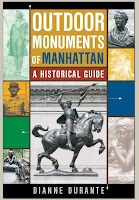
In February 2007 New York University Press will issue Outdoor Monuments of Manhattan: A Historical Guide, on 54 of Manhattan’s best outdoor representational sculptures. I conceived OMOM as a guidebook for New Yorkers and tourists, but it evolved into a discussion of historical and esthetic issues that fascinate me, and I hope will fascinate you as well. For the next two months (through February 2007) I plan to post a paragraph or two every day about one of the OMOM essays: what’s covered in “About the Sculpture” and “About the Subject,” why I chose those particular topics, what I found most surprising when doing the research, and/or what I most regretted deleting.
Since 2002 I’ve been running the website ForgottenDelights.com, which offers comments on dozens of outdoor representational sculptures in New York. The Forgotten Delights site was set up to promote my self-published book Forgotten Delights: The Producers. [NOTE: As of June 2021, the ForgottenDelights.com site is defunct; all material has been moved to DianneDuranteWriter.com.] If you’ve read FDP, you’ll find the format of Outdoor Monuments familiar:
- Introductory section with title, artist, date, size, medium, location
- Photograph of the sculpture
- Sidebar (a substantial quote, often by the person represented or from a contemporary source, sometimes from a poem or novel)
- About the Sculpture (on the sculpture as art)
- About the Subject (on the person or event represented)
Outdoor Monuments has better photos than FDP, a more professional layout and binding, and of course it covers 54 items rather than the 19 in FDP. For anyone interested in learning to look at sculpture with an informed and inquisitive eye, OMOM‘s Appendix A, “How to Read a Sculpture,” will be worth the book’s purchase price, since it sets out a systematic method for looking at a sculpture.
ISBN 987-0-8147-1987-9. Release date: February 2007. $18.95 paperback, $60.00 cloth. 300 pages. Available from New York University Press and Amazon.
Statue of Liberty: OMOM Essay 1
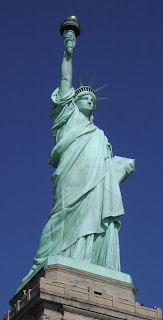
Since the essays in Outdoor Monuments of Manhattan are arranged to be convenient for a walking tour, from the southern end of Manhattan heading north, the first sculpture I had to write about was the Statue of Liberty. That was difficult: I’d seen so many photos and replicas of Liberty that I didn’t actually “see” her any more. What could I possibly write that wouldn’t be trite and repetitious?
I decided to try to shake off the modern context by investigating what Liberty meant to those who commissioned her. It turns out she wasn’t meant to be a welcoming figure for immigrants: she was an advertisement for liberty by a group of men living under a repressive regime. That became the focus of “About the Subject.”
The most delightful discovery in my research on Liberty was a pamphlet written by sculptor Frederic-Auguste Bartholdi to help raise funds for her construction. Bartholdi makes fascinating comments on how he chose the site for Liberty and on the factors he had to consider when designing a huge statue that would sit a mile from the shore. I quote him extensively in “About the Subject” and the Sidebar.
As far as I can tell Bartholdi’s pamphlet hasn’t been reprinted or made available on the Web. I read it on a ratty microfilm at the Humanities Research branch of New York Public Library.
Note 4/22/19: I included excerpts from the Bartholdi pamphlet in The Statue of Liberty: Timeless Art, Political Hot Topic.
John Ericsson: OMOM Essay 2

Ericsson was one of the first New York sculptures I became familiar with, and remains one of my favorites because of what I’ve learned about its subject, who was highly intelligent, innovative, and assertive to the point of tactlessness. If you find that you, too, like Ericsson, Forgotten Delights: The Producers incorporates lengthier quotes from him.
This is the first of ten sculptures in Outdoor Monuments of Manhattan that also appeared in FDP. “About the Subject” focuses on the Battle of the Ironclads in the context of naval warfare in the 19th c. “About the Sculpture” discusses the purpose of portrait sculpture and introduces the idea of selectivity, one of the key concepts in Ayn Rand’s definition of art. Rand’s esthetics forms the basis for my understanding of art.
Giovanni da Verrazzano: OMOM Essay 3
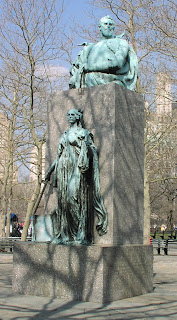
The most challenging part of researching this sculpture was deciphering the inscription, for which credit goes to my nephew’s high-school Italian teacher. Given the inscription, it’s clear that Verrazzano and his allegorical companion are not merely commemorative but polemical. That’s the focus of “About the Sculpture.” “About the Subject” discusses Verrazzano’s voyage to North America, his discovery of New York Harbor, and New York’s development as a commercial center.
Verrazzano is the second of ten sculptures in in Outdoor Monuments of Manhattan that also appeared in Forgotten Delights: The Producers. FDP has more details on Verrazzano’s voyage and a full transcription of the Italian and English inscriptions.
After I’d finished the manuscript of Outdoor Monuments I went to Battery Park to take a better photo of Verrazzano. To my dismay, the monument had disappeared: not even the base was left. Frantic emails to Parks Department officials brought the news that it had been removed for cleaning and will reappear several years from now, when renovations on the subways beneath the park are completed. Since it’s number 3 of 54 essays, removing it would have required not only renumbering the titles of all the subsequent essays, but correcting every single cross-reference as well – and there are a lot of cross-references. I opted to leave Verrazzano in the book and use a photo from the Parks Department’s Photo Archives. The photo that appears above was taken several years ago, before the sculpture was removed for cleaning.
NOTE: The sculpture finally reappeared in 2017! Pics of the renovated monument here.
Continents at U.S. Customs House: OMOM Essay 4

“About the Sculpture” investigates the symbolism of Asia, Africa, Europe and America and how the figures play off against each other. The “aha!” moment for this essay in Outdoor Monuments of Manhattan was when I realized that the figures need not be taken as racist comments about the behavior of people on different continents. They could be understood as representing states of mind and characteristic behavior of different types of people.
I spent quite some time puzzling over what the man next to America is pushing – see the image at upper left. Google is great for text searches, but not very useful for identifying symbols if you don’t know the symbol’s name. A search for “wheel wings symbol” brought me to a tattoo site explaining the meaning of the winged wheel as a police symbol and another explicating the lyrics of the Grateful Dead’s “The Wheel.” Finally (in print), I found a scholar who referred to the winged wheel as the “wheel of progress,” which makes sense visually – it look as if it’s going somewhere fast.
“About the Subject” explains why the U.S. Customs building in New York was so important that its facade rated four major works by one of America’s most important sculptors. Hint: Alexander Hamilton’s ultimately responsible.
Below, details from the other Continents: Asia‘s footstool of human skulls, Europe‘s companion studying a laurel-wreathed skull, and Africa‘s companion leaning on a sphinx.


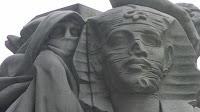
Charging Bull: OMOM Essay 5
Like Liberty, this image is so familiar that I found it difficult to think what to say about it. I jump-started my brain by imagining it with a different texture, a different shape to the tail, a different setting. In “About the Sculpture” I introduce a key point for Outdoor Monuments of Manhattan: the distinction between a sculpture’s subject (the specific person, object or story shown) and its theme (the abstract meaning of the work).
“About the Subject” describes how the artist donated this piece to New York and what he intended it to represent.
I wanted to write about the origin of the stock-market term “bulls and bears,” but was reminded that research on the Net is much more useful for recent events than for historical ones. All the citations of bulls and bears on the Net turned out to be extracts (usually unacknowledged) from the Oxford English Dictionary. I did finally find an interesting quote for the Sidebar on bulls and bears, printed in Harper’s Weekly in 1860. (Harper’s is a wonderful historical resource, but it’s available on the Net by subscription only.)
George Washington: OMOM Essay 6
Several sculptures in Outdoor Monuments of Manhattan have elements that recall Ancient Greece and Rome. In the Washington at Nassau and Wall Streets it’s the fasces, that bundle of rods behind Washington. (And yes, I think the choice not to include the traditional axe for cutting off malefactors’ heads was the right one.) “About the Sculpture” discusses the effect of such elements and the popularity of the Neoclassical style in the late 18th and 19th centuries.
Historians such as Joseph Ellis and David McCullough don’t just tell what happened – they involve their readers by showing the options available in a given period and why people chose one over the other. In “About the Subject” I try to use that approach to present Washington’s 1789 inauguration as his contemporaries might have perceived it. The Sidebar is W. Irving’s vivid description of the difficulties facing Washington as he took office for the first time. For a photo of the whole sculpture from the front, see this essay on Washington, which also includes substantial excerpts from Washington Irving’s biography of George Washington.
Horace Greeley: OMOM Essay 7

Why does Greeley look so disheveled? In “About the Sculpture,” I compare Ward’s Greeley at City Hall to Doyle’s Greeley at Herald Square, and argue that the rumpled look makes the Ward sculpture a better likeness of Greeley. (Objective esthetic evaluation is a topic that’s covered in more detail in Essay 16 of Outdoor Monuments of Manhattan, on Lincoln.)
“About the Subject” includes an paragraph by Greeley (1811-1872) explaining his novel concept for what is covered in his New York Tribune. While Greeley had flaws, quirks, and self-contradictions, I have to admire him for the quote in the Sidebar, in which (at age 31) he asserts his right to disagree with an older and more experienced business partner: “I have given you and I have been ever ready to give you any service in my power, but my understanding, my judgment, my consciousness of conviction, of duty and public good – them I can surrender to no man. You wrong yourself in asking.” (That’s about a quarter of the Sidebar.)
Elsewhere on this site you can read Greeley’s description of New York ca. 1831 and his scathing comments on literature as a vocation.

Nathan Hale: OMOM Essay 8
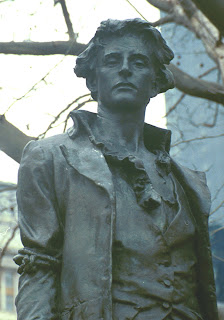
MacMonnies’s Hale has always been one of my favorite New York sculptures. In fact, the discussion of the details of Hale in Outdoor Monuments of Manhattan is based on an article I did way back in 1998, before this book was even conceived of. With regrets, I had to cut the article’s comparison of MacMonnies’s Hale with Pratt’s Hale. The third or fourth revision of the manuscript for Outdoor Monuments was running 20% beyond the length specified in the contract, and something (a lot of somethings, in fact) had to go.
For Outdoor Monuments of Manhattan, I added to “About the Sculpture” the first of several discussions of the purpose of art.
“About the Subject” focuses on the fire that raged in Manhattan just after the British occupation in 1776. The British search for arsonists turned up Hale, who had been operating undercover in the city to gather intelligence for Washington.
In the photo above you can see more clearly the ropes just above Hale’s elbows. If “Invictus” (the sidebar in OMOM) doesn’t suit your mood, try this one.
“Say Not the Struggle Nought Availeth”
Say not the struggle nought availeth,
The labor and the wounds are vain,
The enemy faints not, nor faileth,
And as things have been they remain.If hopes were dupes, fears may be liars;
It may be, in yon smoke concealed,
Your comrades chase e’en now the fliers,
And, but for you, possess the field.For while the tired waves, vainly breaking,
Seem here no painful inch to gain,
Far back, through creeks and inlets making,
Comes silent, flooding in, the main.And not by eastern windows only,
When daylight comes, comes in the light;
In front, the sun climbs slow, how slowly
But westward, look, the land is bright.
Fiorello La Guardia: OMOM Essay 9

My most surprising discovery about La Guardia was that he was once represented as a balloon in the Macy’s Thanksgiving Day parade. I like the energy of Estern’s sculpture, even though I’m vehemently opposed to most of what La Guardia did during his 1933-1945 tenure as mayor of New York (summarized in “About the Subject”).
When I’d edited this essay for Outdoor Monuments of Manhattanseveral times, I suddenly noticed how much La Guardia’s right pant leg contributes to the sense that he’s striding briskly along. I used this to make the point in “About the Sculpture” that you never see everything about a sculpture on first look, or (put positively) that a good sculpture is worth many visits and intense study. I gave myself the task of noticing something new the next 5-6 times I passed one particular sculpture, and sure enough, with that “standing order” in mind I was able greatly to increase my powers of observation.
Since abstract sculptures have predominated in New York for decades, it pleases me that La Guardia is relatively recent (dedicated in 1994), and that its creator, Neil Estern, is still alive and well. Estern’s other works in New York are listed in Appendix C of Outdoor Monuments of Manhattan (“Brief Biographies of Artists”).
Peter Cooper: OMOM Essay 10
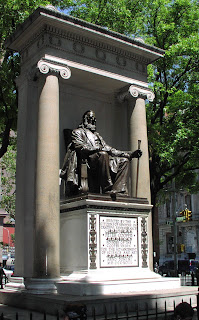
Cooper’s dignified seated figure recalls many earlier works, including Michelangelo’s Mosesand medieval portraits of kings. In “About the Sculpture” I discuss the effect of “quoting” earlier sculptures. In “About the Subject,” I focus on Cooper’s career as a businessman (especially his involvement in railroads) and his founding of the Cooper Union. It was delightful to learn that Saint Gaudens, one of America’s best sculptors and the creator of Cooper, was an early graduate of the Cooper Union.
This is the third of ten sculptures from Forgotten Delights: The Producersthat appears in Outdoor Monuments of Manhattan. Again I abridged the version in OMOM for the sake of space. (The book had to be under a certain number of pages in order to be priced at under $20. Paperback books priced over $20 are more difficult to sell.)
Alexander Lyman Holley: OMOM Essay 11

In the “About the Sculpture” section of this essay in Outdoor Monuments of Manhattan I return to the related issues of selectivity and the purpose of art.
“About the Subject” focuses on how Holley almost single-handedly introduced Bessemer steel to the United States, and then kept those who operated the steel plants up to date on the latest improvements in the process. Before I researched Holley, I had not considered that neither the skyscrapers of Manhattan nor the expansion of the railroads across the U.S. would have been possible without mass-produced steel. Forgotten Delights: The Producersincludes details on the labor- and time-intensive steel-making process before Holley’s time.
Washington Arch: OMOM Essay 12
A good artist only incorporates into a sculpture those details he believes essential to convey his message. As a viewer I enjoy the challenge of trying conscientiously to figure out what each detail means. “About the sculpture” for the Washington Arch involved sorting out eight allegorical figures and four coats of arms. Together these allow the Arch to make a broader statement about Washington than could a single portrait sculpture – even as attractive a sculpture as Ward’s Washington at Wall St.
In the course of my research on the Arch I brushed up on my Latin to ponder Washington’s motto, “Exitus acta probat,” which appears twice on the Arch and seemed incongruous for him. (The usual translation is “The end justifies the means.”) I also puzzled over the object held by Athena/Wisdom – see photo. Unable to identify it at first, second or third sight, I looked up early accounts of the Washington Arch to see if an enterprising New York Times reporter had interviewed the sculptor. No luck there, either. This is one of the few cases in Outdoor Monuments of Manhattan when I grudgingly admitted defeat.
“About the Subject” focuses on Washington’s participation in the Constitutional Convention, including the source and context of the inscription on the south side of the Arch: “Let us raise a standard to which the wise and the honest can repair. The event is in the hand of God.” Fans of Ayn Rand’s Atlas Shrugged will recognize it as the oblique reference from the discussion of Directive 10-289:
“Whatever type of men we’re counting on and planning for,” said Dr. Ferris, “there’s a certain old-fashioned quotation which we may safely forget: the one about counting on the wise and the honest. We don’t have to consider them. They’re out of date.”
Rand, Atlas, “Miracle Metal” chapter, p. 501 pb
Added 1/9/07: Thanks to Quent Cordair of Quent Cordair Fine Art, who suggested that Athena might be holding an old-fashioned oil lamp. He noted, “Athena/Wisdom lighting the way through the darkness of difficulties and uncertainty would make some sense thematically too.” It does look like an oil lamp, and the idea of Athena shedding light does make sense. True, I’ve never seen Athena with an oil lamp (and as a trained classical scholar I’ve seen hundreds of Ancient Greek images of Athena), but this Athena is early 20th c., and might not abide by the rules of ancient iconography.
Thanks also to Harry Mullin, who discovered that the New-York Historical Society has a treasure trove of documents on the Washington Arch. I’d love to go through them, but at the moment I’m too pressed for time.
George Washington at Union Square: OMOM Essay 13
I’ve discussed the Washington at Union Square at length in Getting More Enjoyment from Art You Love. In Outdoor Monuments of Manhattan, I focus on identifying the theme (a process I first mentioned in Essay 5, Charging Bull), and again address the question of what an artist achieves by “quoting” other sculptures. In this case, the sculptor quoted an equestrian portrait of Emperor Marcus Aurelius that has stood in Rome for millennia – largely because medieval Christians assumed it represented Constantine, the first Roman emperor to convert to Christianity (A.D. 312).
“About the Subject” describes Washington’s ceremonial return to New York in 1783, after seven years of British occupation. For over a century that event was celebrated every November 25 as “Evacuation Day.”
Most photos of this Washington are taken from the east side. In the photo above, you can see why: if you’re close enough on the west side to take a photo without a telephoto lens, Washington’s arm blocks his face. If I backed off 10-20 yards, I could probably get a decent photo of that side using my new 12x optical lens and a tripod. For more on the problems of photographing sculpture, see my notes on photographing sculptures.
Marquis de Lafayette: OMOM Essay 14
When I looked at the sculptures in Outdoor Monuments of Manhattanin historical order, the difference between this sculpture of Lafayette and those of his contemporaries Washington, Hamilton and Jefferson (Essays 6, 12, 13, 43, 50, 53) was striking. In “About the Sculpture” I point out the details that convey Lafayette’s aristocratic elegance.
I noticed the peculiar shape beneath Lafayette’s feet only after dozens of visits and several drafts of the essay. Rather than reworking the essay to include it, I use it to challenge the reader to begin drawing his own conclusions about details of the sculpture. I am anxious to have the reader start such observation and inference early on, because I want him to finish Outdoor Monuments of Manhattanconfident that he can understand art on his own, without the intervention of an art critic or art historian. Appendix A, “How to Read a Sculpture,” is a summary guide to the process.
“About the Subject” focuses on the philosophical differences between the American and French Revolutions, and Lafayette’s role in both.
On the Forgotten Delights site I discuss Lafayette’s non-invasion of Canada in 1778.
Abraham Lincoln: OMOM Essay 15
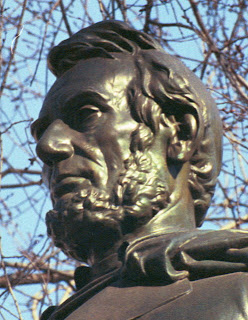
“About the Sculpture” discusses why Saint Gaudens’s Standing Lincoln in Chicago is superior as a work of art to Henry Kirke Brown’s Lincoln in Union Square. I’m particularly happy to have been given permission to print a photo of the Saint Gaudens Lincoln taken by David Finn, who I’ve decided (after years of compulsively browsing art books) is my favorite sculpture photographer. Meeting Mr. Finn was one of the few joys of the two long years I spent seeking a publisher interested in a book on outdoor sculpture in New York.
I had seen occasional references to President Lincoln’s suspension of habeas corpus during the Civil War, but hadn’t learned enough to decide whether it was a justified wartime measure or a breach of civil liberties. While researching Lincoln for Outdoor Monuments of Manhattan I investigated the habeas corpus issue further, and ended up writing “About the Subject” on one specific case of it in 1863: Lincoln’s treatment of Clement Vallandigham, a Northern politician who was a very vocal Confederate sympathizer. The Vallandigham case was one of the inspirations for a famous short story you may recall from your high-school days: Edward Everett Hale’s “The Man Without a Country.”
Peter Stuyvesant: OMOM Essay 16
After two drafts of Outdoor Monuments of Manhattan I still had no “About the Sculpture” section for this essay. Finally I asked myself not “What should I write?” but “Why is it so difficult for me to write about this sculpture?” As often happens, asking the right question was more than half the battle. I realized that the style of the sculpture, specifically the texture, bores me so much that I’d prefer to look at almost any sculpture in Outdoor Monuments of Manhattan rather than this one. In the photo you can see that the sculptor has used the same mushy texture for Stuyvesant’s face, hair and jacket. Historically the man to blame for this is the French sculptor Rodin, whom I discuss in Essay 50 (Jefferson).
Stuyvesant as governor-general of New Netherlands from 1647 to 1664 was anything but boring – see Washington Irving’s Knickerbocker’s History of New York (excerpts here), or, more seriously, Shorto’s well-written Island at the Center of the World. As a variation on the usual third-person narrative, I tried to capture the immediacy of Stuyvesant’s situation in 1664 by writing “About the Subject” in the second person: “Imagine you’re …” This technique could get old quickly – I only did it once.
Edwin Booth as Hamlet: OMOM Essay 17
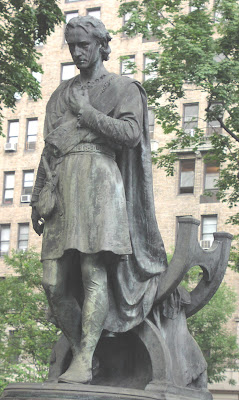
Booth caused me even more problems than Stuyvesant (Essay 16). I went through at least two drafts of Outdoor Monuments of Manhattan without having any focus for “About the Sculpture” or “About the Subject.” Again I solved the problem by asking what made me not want to think about this sculpture. This time rooting about in my subconscious turned up the fact that I find the plot and characters of Hamletdepressing and exasperating; and I disliked actor Edwin Booth (d. 1893) because Hamlet was his preferred role.
Since many people do like Hamlet, though, I decided it was time for an “About the Sculpture” on why people can react to a work of art in such violently different ways. Emotional reactions to works of art are also discussed briefly in Getting More Enjoyment from Art You Love.
While researching Booth I learned, to my amazement, that from the 17th to 19th centuries it was common for Shakespeare to be performed in “modernized” versions. Many were the work of Colley Cibber (d. 1757), one of Britain’s less distinguished poets laureate. The Sidebar juxtaposes substantial passages from Cibber and Shakespeare. “About the Subject” acknowledges Booth’s role in bringing Shakespeare’s own words back on stage.
And then there was the photo. Gramercy Park has been closed to the public since its creation in 1831: only residents of surrounding buildings have keys to the gates in the high iron fence. Booth stands at the center of the park, half a city block from the nearest public sidewalk. In 2005 I owned a camera with a 3x optical zoom, inadequate for a good photo at that distance. It took dozens of relentlessly polite and patient emails and phone calls to find someone who would allow me in, under escort, to photograph Booth.
Roscoe Conkling: OMOM Essay 18
As opposed to Booth (Essay 17), my problem with prominent New York politician Conkling wasn’t lack of reaction but indecision. A contemporary said, “He stood for independence, for courage, and above all for absolute integrity.” A later biographer denounced him as “one of the harshest, strictest, most narrow-minded of all political bosses. Possibly like Pooh Bah he was born sneering.” Eventually I made “About the Sculpture” a discussion of how one’s knowledge affects one’s interpretation of and reaction to art. Thus it’s a sequel and elaboration of the discussion of emotional reactions to sculpture that began in Essay 17 of Outdoor Monuments of Manhattan.
I spent considerable time searching for an objective evaluation of Conkling, but with a deadline impending, finally focused “About the Subject” on the primary sources one would have to research in order pass judgment on Conkling’s character and career.
Farragut Monument: OMOM Essay 19
“About the Sculpture” discusses why Farragut was a turning point in American sculpture: which details of pose, costume and pedestal made it drastically different from earlier works such as Brown’s Lincoln(Essay 15). I vividly remember my delight at noticing how the lines of the pedestal and the uniform lead the viewer’s gaze inexorably from the broad base to Farragut’s head. (The photo shows the left side of the base, with the allegorical figure of Loyalty.) In a Saint Gaudens work, nothing is accidental.
In “About the Sculpture” I focused on the 1864 Battle of Mobile Bay, partly because it’s where soon-to-be-Admiral Farragut bellowed “Full speed ahead, and damn the torpedoes!”, and partly because the battle involved the use of ironclads by both Union and Confederacy. Surprisingly, Farragut preferred wooden ships to ironclads. After researching Ericsson (Essay 2 of Outdoor Monuments of Manhattan), I’d assumed that the advantages of ironclads were overwhelming and indisputable.
Samuel Rea: OMOM Essay 20

“About the Subject” in Outdoor Monuments of Manhattan focuses on the rise and fall of Pennsylvania Station. In the first decade of the 20th c., Rea supervised Penn Station’s design and construction; a model of it stands at his side in this sculpture. (See photo.) Its demolition by the Pennsylvania Railroad in the early 1960s led to the creation of the Landmarks Preservation Commission, one of New York’s more intrusive restrictions on private property rights. Why a major corporation would wantonly destroy such an architectural gem had always puzzled me. I was indignant (but not tremendously surprised) to learn that we ought to be blaming the demolition on the government rather than the PRR.
“About the Sculpture” compares this sculpture of Rea to a description of him in the New York Times, and tells of the sculpture’s original setting in Pennsylvania Station.
Bell Ringers’s Monument (James Gordon Bennett Memorial): OMOM Essay 21

Every source I’ve read mentions the sensationalism of the New York Herald and the New York Tribune in the 19th c., but few cite concrete examples. I decided to see how one major event was covered by each of the New York newspapers of the time, and after some exploratory research settled on Wall Street’s first Black Friday, 9/24/1869. The fascinating variety of headlines in Bennett’s Herald, Greeley’s Tribune, Hamilton and Bryant’s New York Post, and the New York Times is the focus of “About the Subject.”
In “About the Sculpture” I discuss how the complex composition of this piece focuses attention on Athena. I enjoyed working in a reference to the owl fetish of New York Herald publisher James Gordon Bennett, Jr., who planned to construct for fellow Manhattanites a 125-foot tall owl with an observation deck behind its eye sockets. When Athena adorned the Herald Building’s roof, she was flanked by numerous owls whose eyes blinked green throughout the night. Some of them are now scattered near the Bell Ringers’ Monument in the small park east of Macy’s Herald Square. (See photo.)
Primary sources sometimes reveal that contemporaries disparaged what we now accept as beautiful. Bennett’s new headquarters for the Herald, a two-story Renaissance-style palazzo at Herald Square, was lauded by Harper’s Weekly in 1893 as a relief from other buildings going up at the time, which it condemned as of “skyscraping ugliness.” (More of this article appears in the Sidebar of Outdoor Monuments of Manhattan.) In 1890, New York’s tallest structure was the 309-foot World Building, all of 20 or so stories high.
William Cullen Bryant Memorial: OMOM Essay 22
Until I started researching this sculpture I hadn’t read anything by Bryant (d. 1878) since high school. The only work of his that I remembered was “Thanatopsis,” a singularly depressing and long-winded poem. Although “Thanatopsis” brought Bryant fame, I find works such as “My Autumn Walk” much more appealing. (It’s excerpted in the Outdoor Monuments of Manhattan Sidebar; see more here.) “About the Subject” discusses the rise and fall of Bryant’s reputation as a poet and his influence on New York politics and literary taste during the fifty years he served as editor of the New York Post.
In “About the Sculpture” I compare Bryant to Cooper (Essay 10) and consider the City Beautiful movement of the late 19th c., which promoted art as a didactic tool for New York’s illiterate masses.
Gertrude Stein: OMOM Essay 23
I had a vague dislike of Gertrude Stein until I researched her for this essay. Now my dislike is intense. Read her rant on the comma (the Sidebar to this essay) and you’ll see why. “About the Sculpture” compares this work to Picasso’s famous 1906 portrait in the Metropolitan Museum. For copyright reasons I can’t include a photo of Davidson’s Stein in this blog: I purchased permission to use one in Outdoor Monuments of Manhattan, but not on the web. You can, however, see the piece in progress in Man Ray’s photo of Davidson sculpting Stein. For “About the Subject” I found a bewildered comment by Davidson and a laugh-aloud New York Times subhead for Stein’s obituary (1946). Another laugh-aloud moment ended up on the cutting-room floor of OMOM. Stein wrote of Oakland, California, where she spent part of her childhood: “What was the use of my having come from Oakland it was not natural to have come from there yes write about it if I like or anything if I like but not there, there is no there there.” Since the 1980s or 1990s, Oakland City Center has displayed an abstract work by Roslyn Mazzilli entitled, simply, There. So now there is a There there.
William Earl Dodge: OMOM Essay 24
In “About the Sculpture” I consider what details make this figure of a businessman so different from those of Rea and Vanderbilt(Essays 20 and 25). I also note that all the portrait sculptures erected in the 19th c. were meant to remind viewers of people worthy of emulation. More on this under Duffy (Essay 27).
My favorite story about Dodge (d. 1883), which I didn’t manage to fit into either Outdoor Monuments of Manhattan or Forgotten Delights: The Producers, is his dialogue with President-Elect Lincoln in February 1861. As Burrows and Wallace describe it:
William E. Dodge, industrialist and financier, explained that New Yorkers were nervous about the position he would take toward the South in his forthcoming inaugural and wanted to know “whether the grass shall grow in the streets of our commercial cities.” Lincoln responded pleasantly that “if it depends upon me, the grass will not grow anywhere except in the fields and meadows.” But when Dodge pressed him, asking if this meant he would yield to the just demands of the South, Lincoln replied grimly that the Constitution must be “respected, obeyed, enforced, and defended, let the grass grow where it may.”
Gotham: A History of New York City to 1898 (p. 867)
It proved surprisingly difficult to gather biographical information about Dodge. Although he co-founded Phelps Dodge, today one of the world’s leading mining companies, Dodge isn’t in the American National Biography or the Encyclopedia of New York City. I ended up scrounging for information in 19th-c. biographical dictionaries at the New-York Historical Society. More details on my research for Dodge are included in Forgotten Delights: The Producers. (This is the sixth of ten sculptures covered in both OMOM and FDP.)
Cornelius Vanderbilt: OMOM Essay 25
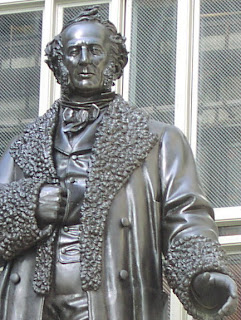
Vanderbilt has been so widely maligned that even I (who am very favorably disposed to businessmen) expected to dislike him. The biggest surprise in researching him was that his New York Times obituary (1877, excerpted in the Sidebar of Outdoor Monuments of Manhattan) was largely positive. Vanderbilt’s productive career is the focus of “About the Subject.” It’s an abridged version of what appears in Forgotten Delights: The Producers. On the exigencies of pages and pricing, see my blog entry of 1/2/07 on Cooper, OMOM Essay 10.
“About the Sculpture” discusses the importance of setting. Vanderbiltwas not intended to be seen against the vast, dark expanse of Grand Central Terminal’s windows.
Nearly all my photos of Vanderbilt are taken from the same angle. If you visit the sculpture you’ll see why: shooting from any other angle would involve dodging high-speed traffic (mostly terrifying New York taxis) on the Park Avenue Viaduct.
Glory of Commerce: OMOM Essay 26

A photo of Hermes being carved (ca. 1914) shows a worker lying full-length along Hermes’ forearm, which gave me for the first time a sense of how enormous this this sculpture atop Grand Central Terminal’s façade is. Another surprise was that the sculptor originally planned to have mirror images of Hercules flanking Hermes. Had he carried that plan through, there would have been no complex symbolism showing business as a combination of physical and mental effort. See “About the Sculpture” in Outdoor Monuments of Manhattan.
“About the Subject” describes the remarkable engineering and execution of Grand Central Terminal. Over the years required to demolish the Depot and construct the Terminal on the same site, trains continued to move on regular schedules.
Father Francis P. Duffy: OMOM Essay 27
“About the Sculpture” for Duffy is another exercise in determining the theme of a sculpture from its details. I also comment on the change in the subject and spirit of war memorials from the Civil War to the Viet Nam War, which I’ve discussed at greater length in From Portraits to Puddles: New York Memorials from the Civil War to the World Trade Center Memorial .
From high school I had a basic knowledge of the causes of World War I, and from wide reading since then I knew it was considered “the war to end all wars.” But I never grasped the horrors that faced soldiers there until I read Father Duffy’s Story (1919) as research for this essay: bombs dropped from airplanes, chemical weapons that blinded and suffocated, plus sweeping epidemics of influenza, mumps, measles, etc., that killed thousands as they lay in the trenches or makeshift hospitals. The Sidebar of Outdoor Monuments of Manhattanis Duffy’s description of men stricken by mustard gas.
Prometheus: OMOM Essay 28
Since Prometheus is now an icon of New York, it’s jolting to read the negative comments made when it was unveiled in 1934: “just sprung from a bowl of hot soup,” for example. In “About the Sculpture” I discuss this, and also return to the matter of subject vs. theme (see Charging Bull, Essay 5) – specifically how the theme would have differed had Manship chosen another episode from the Prometheus myth.
“About the Subject” in Outdoor Monuments of Manhattan explains how the artists and themes for Rockefeller Center artwork were chosen, and why by the 1930s it was almost inconceivable that statues celebrating capitalism and businessmen would have been erected there, even though Rockefeller Center was built by America’s wealthiest businessman.
Atlas at Rockefeller Center: OMOM Essay 29

Prometheus was mocked when it was unveiled. Atlas(dedicated in 1937) drew a crowd of protesters. They said the face of Atlas looked too much like Benito Mussolini’s. In “About the Subject” I present the evidence for that, along with critics’ comments. (“Contains much material extraneous to art,” sniped the director of the Whitney Museum. I’m still trying to make sense of that one.)
“About the Sculpture” returns to the issue of emotional reactions to art. Some fans of Ayn Rand love Atlas. A few (including me) dislike it intensely. Why would people with more or less the same values disagree on a work of art?
The Sidebar of this essay in Outdoor Monuments of Manhattan is the only one with a quote from Ayn Rand. Bet you can guess which passage of which work is quoted.
News: OMOM Essay 30
The surprise in researching this sculpture was that Noguchi, who’s famous for his abstract works, once trained under Gutzon Borglum, who conceived Mount Rushmore and sculpted Butterfield (Essay 52). I use Noguchi’s abstract works as the springboard for a discussion of Ayn Rand’s theory of art’s nature, function and purpose. In the Introduction to OMOM this discussion would have been bewildering for anyone unfamiliar with Ayn Rand’s esthetics. At this point, midway through the book, I’m counting on the reader to have enough context to follow and retain such a discussion, even if he doesn’t immediately agree. “About the Subject” recounts the origin and achievements of the Associated Press. For copyright reasons I can’t include a photo of News on this blog, but there is one (bought and paid for) in Outdoor Monuments of Manhattan. You can also see this Noguchi relief on the Net.
Sherman Monument: OMOM Essay 31
I’m fond of Saint Gaudens not only for the sculptures he produced, but for the way he approached art. “About the Sculpture” describes Saint Gaudens proposing to improve his assistants’ skills by a hook-and-spring arrangement … You’ll have to read it. Several critics have commented disparagingly that the striding woman and the equestrian figure don’t seem to belong together, so I was careful to point out the elements that weld them into a visual unit.
For “About the Subject” in Outdoor Monuments of Manhattanthe obvious choice was Sherman’s March through Georgia: see my post on that topic. But at some point I stumbled across a reference to Sherman’s 1863 court-martial of a journalist. This led to a fascinating investigation of 19th-c. communication technology, media and politics. The Sidebar gives an excerpt on the media from Sherman’s Memoirs (which ought to rank as great American literature).
I sometimes fantasize about taking a high-powered water pistol with me when I photograph Sherman. It’s so extraordinarily difficult to find a good angle that doesn’t include multiple pigeons. I only want to make them fly away for a few minutes … Then again, they’re destroying the gilding on the statue, so I’d prefer they perch elsewhere.
NOTE: Sherman has been regilded as of ca. 2017, and the very unobtrusive anti-pigeon devices have kept the birds off of it.
Simon Bolivar: OMOM Essay 32
Bolivar (d. 1830) is often called “the Washington of South America. “About the Subject” compares Bolivar’s milieu and career to Washington’s.
I was surprised to learn that this was the third Bolivar sculpture designed for New York. See this post for the story of what happened after the first one was removed from its pedestal. In “About the Sculpture” I compare this Bolivar to nearby Marti (Essay 33) and San Martin, and to the Washington at Union Square (Essay 13).
It’s virtually impossible to see or photograph Bolivar. As you can see in the otherwise useless photo above, it sits on a towering pedestal and for much of the year is heavily shaded by Central Park’s trees. For OMOM, I had to resign myself to paying for the right to reproduce a Parks Department photo taken decades ago, when the statue was on a lower pedestal.
Jose Marti: OMOM Essay 33

In “About the Sculpture” I return to the matter of selectivity, in this case the artist’s choice of what moment to show in a portrait sculpture. This segues in “About the Subject” to why Marti is shown as he’s dying – i.e., why his death in 1895 helped him become a hero to Cuba’s multitude of political factions.
The caliber of Marti’s writing was a pleasant surprise. His description of the Blizzard of 1888 in New York is extremely evocative. On the other hand, the philosophy behind his political writings is confusing, to say the least.
Maine Monument: OMOM Essay 34
In “About the Sculpture” I wanted to stress that a work that’s difficult to grasp, – for example, a complex allegorical sculpture such as the Maine Monument – can be very expressive once you understand it. Thinking this point would be more obvious in a verbal comparison, I amused myself by skimming all Shakespeare’s sonnets while trying to recall mundane pop-music lyrics that expressed the same sentiments.
In “About the Subject” of Outdoor Monuments of Manhattan, I delve into why the USS Maine was moored in Havana harbor and why investigators were unable to determine the cause of the explosion that blew her apart in February 1898. A gruesome description by one of the divers of the underwater investigation: Charles Morgan’s account.
Columbus Monument: OMOM Essay 35

In “About the Sculpture” I discuss how the many subsidiary elements of the Monument combine with the figure of Columbus to convey one distinct message about him. In Forgotten Delights: The Producers, I had rather more fun with this section, proposing changes to the subsidiary details that completely changed the Monument‘s message. Alas, that was another section cut from Outdoor Monuments of Manhattanto keep it to a manageable length. (See the 1/2/07 blog entry on Cooper, OMOM Essay 10.)
“About the Subject” focuses on the combination of thoughts and actions that made Columbus unique.
Christopher Columbus: OMOM Essay 36
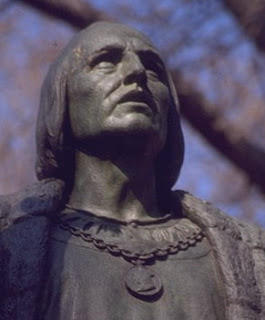
In this “About the Sculpture” I zoom in from the sculpture as a whole to one detail: the gesture of Columbus’s left hand. Outdoor Monuments of Manhattanadds a comparison with Roscoe Conkling‘s hand (Essay 18) to the comparison with Vanderbilt‘s hand that appeared in Forgotten Delights: The Producers.
“About the Subject” mentions a few of the festivities honoring the 400th anniversary of Columbus’s first voyage to America. Among them was the 1893 Columbian Exposition in Chicago, the setting for Erik Larson’s bestseller The Devil in the White City. (I rarely read true crime stories, but that one was excellent.)
In my usual obsession with identifying details (see America in Essay 4 and the Washington Arch, Essay 12), I spent considerable time trying to get a good view of the medallion hanging around Columbus’s neck. I’m fairly certain it’s a woman, and I’d guess that it’s Columbus’s patron Queen Isabella – but it might be the Virgin Mary. I didn’t have the nerve to ask the Parks Department if I could borrow one of their phone-repair cherry-picker tree-trimmer lifts to inspect it more closely.
If you admire Columbus, go to the Columbus Monuments Pages: the man who runs the site attempts to list and post an image of every known sculpture of Columbus. Of those I’ve seen, my favorite is one by Ludwig Habich at Bremerhaven, Germany. Look it up in the geographical index in the left-hand frame.
William Shakespeare: OMOM Essay 37
“About the Sculpture” for this essay was challenging because I aimed to explain Ayn Rand’s term “metaphysical value-judgments.” By this point in Outdoor Monuments of Manhattan,I had discussed so many ideas that were implied by sculptures (rather than explicitly illustrated) that I thought readers would have the necessary foundation for a discussion of MVJs. The essay’s hook is the description of a laser technology that creates the equivalent of a 3-D photograph, which introduces the issue of why a mechanical reproduction isn’t art, which leads to selectivity, and thence to why an artist would select a certain subject or detail over others.
“About the Subject” reviews New Yorkers’ attitudes toward Shakespeare through the 19th century. Did you know that in 1849 twenty-two people were killed at Astor Place in riots over a certain actor’s portrayal of Macbeth?
Richard Morris Hunt Memorial: OMOM Essay 38
In “About the Sculpture” I mention a benefit of looking that art that you can enjoy even if you disagree vehemently with what’s represented: the pleasure of seeing a difficult problem resolutely tackled and brilliantly solved. In the Afterword of Outdoor Monuments of Manhattan,I discuss at greater length the benefits of studying sculpture.
The building that Hunt (d. 1895) designed for Greeley’s New York Tribune (see Essays 7 and 21) was twice as tall as any other commercial building in New York, but did not qualify as a skyscraper by the standards of most architectural historians. More on the 1873 Tribune Building in “About the Subject.”
In the Sidebar sculptor Karl Bitter, who worked with Hunt and also created the Schurz Memorial (Essay 51), vividly evokes Hunt’s character. I love it when I can have one historical figure in OMOM comment on another.
King Jagiello: OMOM Essay 39
Why do we have a statue in Central Park of a medieval king of Poland? And why would Hitler surely have destroyed this sculpture, had it been returned to Poland after the New York World’s Fair of 1939? That’s the focus of “About the Sculpture.” “About the Subject” focuses on the battle between Jagiello’s army and the Teutonic Knights at Grunwald (1410).
Several sources called this Jagiello a copy of the Cracow statue of Jagiello that was sponsored by world-renowned pianist Ignacy Paderewski and was destroyed on Hitler’s orders. Although I didn’t have space to discuss this in Outdoor Monuments of Manhattan, research showed that Central Park’s Jagiello is not a copy of Paderewski’s, as you can see by comparing images of it on Google.
Eleanor Roosevelt: OMOM Essay 40
The surprise in writing this essay was how intensely I came to dislike Eleanor Roosevelt. “About the Subject” originally focused an action that made my blood boil, which occurred during her tenure as assistant director of the Office of Civilian Defense. The amorphous aims of the OCD (established by FDR in May 1941) included protection of the civilian population, maintenance of morale and promotion of volunteer involvement in defense. Director Fiorello LaGuardia (Essay 9), juggling his OCD and mayoral duties, focused on basics such as air raid procedures and black-out drills. Mrs. Roosevelt, however, allotted OCD funds for day-care and health services. Not long after Pearl Harbor she added long-time friend and professional dancer Mayris Chaney to the OCD payroll. Rhythmic and folk dancing, she told the New York Times, had proved in England to have “a definite part” in war-time programs. Even after a furor that led to her resignation, Mrs. Roosevelt reiterated her belief that “better nutrition, better housing, better day-by-day medical care, better education, better recreation for every age” were essential to national defense. A couple months after I’d submitted the manuscript of Outdoor Monuments of Manhattan – when I was already deeply involved in another project – my editor at New York University Press pointed out that the tone of this “About the Subject” was far more polemical than anything else in the book, and just didn’t fit in a guidebook with excursions into art theory. Once he pointed it out I had to admit he was right about the tone, but since I couldn’t find any anecdotes on Mrs. Roosevelt that made me like her, I settled for compiling a biographical sketch. I consider it one of the most insipid sections of OMOM.
“About the Sculpture,” on the other hand, was interesting to write because it tackles the issue of evaluating a sculpture philosophically, as opposed to philosophically evaluating the person represented. Eleanor Roosevelt is the most recent sculpture to appear in OMOM, having been dedicated in 1996. Other representational sculptures have been dedicated in New York since then that don’t appear in the book, for example the under-lifesize portrait of Benito Juarez in Bryant Park.
The blog gets no photo of this sculpture, because I forgot to ask the sculptor for permission to use images on the web as well as in the book.
Verdi Monument: OMOM Essay 41
After hours of cranking through microfilm copies of Il Progresso Italo-Americano, whose editor spearheaded the fundraising for the Verdi Monument, I had found no explanation for why Aida, Leonora, Othello and Falstaff were chosen over Verdi’s other characters to be represented on the Verdi Monument. At that point John Haralabopoulos, opera buff and member of the Forgotten Delights update list [now the Sunday Recommendations list], became fascinated by the question, and did far more research than I would have had the knowledge or patience to do. I greatly enjoyed his reports of his findings at Lincoln Center and elsewhere.
“About the Subject” in Outdoor Monuments of Manhattanfocuses how Verdi came to write “Va, pensiero” and why it became an Italian “national” anthem by the mid-19th c., decades before the peninsula was unified and independent.
Above: Aida. Below: Falstaff, Leonora, Otello.

Theodore Roosevelt: OMOM Essay 42

I was surprised to learn that President Theodore Roosevelt (d. 1919), soldier, politician and hunter, was also very interested in art. He wrote a perceptive review of the Armory Show of 1913, at which America was introduced to “modern” European art such as Cubism. “About the Sculpture” focuses on his cooperation with Augustus Saint Gaudens (Essays 19 and 31 of Outdoor Monuments of Manhattan), then America’s most prominent sculptor, on the design of the $20 gold piece. TR suspected the design of the new Double Eagle (see photos below) would get him impeached: “About the Subject” in tells why.
In “About the Sculpture” I pull back again to look at the big picture: the setting in which Roosevelt was meant to be seen, which included part of the east facade of the American Museum of Natural History and an enormous plaza (never constructed) that would have spread into Central Park.
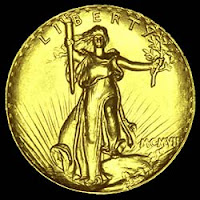

Alexander Hamilton (Central Park): OMOM Essay 43
In “About the Sculpture” I consider why Manhattan has four sculptures of Hamilton (d. 1804) – more than of any other person, including George Washington – and how the fact that this one is of granite rather than the usual bronze or marble affects what the artist could do and how we perceive it.
“About the Subject” in Outdoor Monuments of Manhattancompares Hamilton’s and Theodore Roosevelt’s ideas of “big government.” Times do change.
In 2004, I gave a walking tour of the Hamilton sculptures. It eventually morphed into Alexander Hamilton: A Brief Biography, with notes at the end on all four sculptures of Hamilton.
Joan of Arc: OMOM Essay 44
“About the Sculpture” discusses why a basic knowledge of Western civilization is a requirement for looking at Western sculpture. An early draft also included quite a lengthy description of the process by which I identified the theme of Joan of Arc. For the sake of better flow in the main text, most of that description was eventually shifted to “How to Read a Sculpture” (Appendix A in Outdoor Monuments of Manhattan) as a practical demonstration of how to work out a theme.
“About the Subject” sketches Joan’s role in the battle between the French and English kings in 1428.
This is another difficult sculpture to photograph. From the hillside below one can barely see Joan‘s face, and her sword – a crucial element in the composition – tends to disappear against surrounding trees and buildings. After dozens of attempts at various times of day and year, I finally happened to take the photo that appears in the book, in which the light hits her sword and makes it stand out from the background.
Firemen’s Memorial: OMOM Essay 45
In “About the Sculpture” I examine how the bronze relief and two groups of marble figures combine to make a vivid statement about the excitement and hazards of firefighting. Then I suggest that the reader imagine how extraordinarily inexpressive this memorial would be were it only a list of names. In From Portraits to Puddles, I argue (with additional examples) that for any memorial, including the World Trade Center memorial, representational sculpture is more evocative than a list of names set in landscape architecture.
“About the Subject” surveys major fires in New York from 1776, when Nathan Hale (Essay 8 of Outdoor Monuments of Manhattan) was arrested as a possible arsonist, until 1908, when the death of a 35-year-veteran of the New York Fire Department inspired the creation of this memorial.
For the Sidebar it amused me to use, in a very literal sense, a few lines from my favorite song from The Scarlet Pimpernel.
Below: the Vitruvian wave is usually a simple running spiral, but on the Firemen’s Memorial, flame and smoke lick its edges.

Straus Memorial: OMOM Essay 46
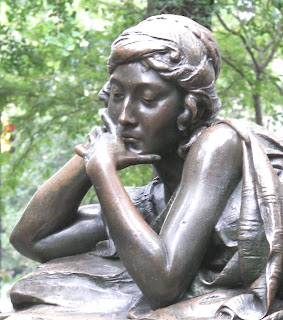
“About the Sculpture” is an exercise in working out the identity of a sculpture when it’s not immediately obvious. I also make the point that learning to look systematically at a sculpture allows you to spend far more time than you might have expected with art that appeals to you. For more on that, see Getting More Enjoyment from Art You Love.
“About the Subject” in Outdoor Monuments of Manhattanis on Isidor and Ida Straus. Rather than dwelling on their deaths on the Titanic in 1912, I focused on Straus as an early co-owner of Macy’s department store.
Dr. James Marion Sims: OMOM Essay 47

“About the Subject” describes how Sims almost single-handedly established the specialty of gynecology, at a time when women routinely suffered and died from mysterious “female complaints.” Sims was also one of the first American physicians to treat cancer patients, who were considered untreatable and almost untouchable through most of the 19th c. More on that in Forgotten Delights: The Producers. (Sims is the tenth and final sculpture to appear in FDP as well as Outdoor Monuments of Manhattan.)
As I discuss in “About the Sculpture,” this is the only case I can think of in OMOM where a new pedestal and a new setting are an improvement over the originals. I was hoping there would be space in the book for a photo of the pedestal as well as Sims; since there wasn’t, I’m giving you one here that you can zoom in on to read the inscriptions.
NOTE: In early 2019, Sims was removed from Central Park. He’ll be re-erected in the Green-Wood Cemetery, Brooklyn.
De Witt Clinton: OMOM Essay 48
My father’s repertoire for long car rides included:
Low bridge, everybody down
Low bridge ’cause we’re coming to a town.
And you’ll always know your neighbor
You’ll always know your pal
If you’ve ever navigated on the Erie Canal.
As a child I pictured that canal just like the narrow, silted-up canal that meandered along the Susquehanna River near my hometown. Imagine my surprise when I discovered that the Erie Canal, which De Witt Clinton tirelessly promoted, was one of the major technological achievements of the early 19th c., and was also the major reason New York outstripped Philadelphia and Boston as a commercial center.
I love learning new facts and ideas, but some of the most satisfying moments in my wide-ranging research for Outdoor Monuments of Manhattan came when a disconnected scrap of old knowledge (like the Erie Canal song) slid smoothly into a niche in my newly expanded view of the world.
“About the Sculpture” compares this portrait of Clinton (d. 1828) to others at the Green-Wood Cemetery in Brooklyn and on the Surrogate’s Court at Chambers and Centre Streets in Manhattan (photo at above).
The close-up of Clinton’s head at the beginning of this post is an object lesson on why one shouldn’t bother taking a photo of a sculpture when bright sunlight is hitting it. A Photoshop expert might be able to fix those harsh contrasts. Me, I prefer trying to shoot in more suitable weather. Here’s a picture taken recently, when the sun wasn’t shining on De Witt. Much better.
See my tips on photographing sculpture.

Alma Mater: OMOM Essay 49
Searching for stories on Alma Mater in the New York Times, I came across a brief 1970 article noting that someone had thrown a bomb at her. That shocked me, and what shocked me even more was the fact that the bombing raised so little comment – apparently because at the time, there were too many other bombings and riots for it to be news-worthy. I place the Alma Mater bombing in that context in “About the Subject.”
Alas, I didn’t have space in Outdoor Monuments of Manhattan to include excerpts from the New York Times Magazine symposium “Are We in the Middle of the ‘Second American Revolution’?” (5/17/1970). It included an analysis by Ayn Rand that seemed to have been written in a different universe from the responses of the other participants. (See “From a Symposium” in Return of the Primitive: The Anti-Industrial Revolution.) To appreciate Rand’s clarity and incisiveness, read the other contributions to the symposium.
“About the Sculpture” describes the symbolism of Alma Mater.
Incidentally, the bomb hit the left side of Alma Mater as you look at her, but the sculpture was repaired so well that no damage is visible.
Thomas Jefferson: OMOM Essay 50

“About the Sculpture” discusses how the texture of Jefferson relates to the works of Rodin, who influenced many American sculptors in the early 20th c. For “About the Subject” I decided to focus on the 1803 Louisiana Purchase, since it could be linked to several other sculptures in Outdoor Monuments of Manhattan : Lafayette (Essay 14), Lewis and Clark (Essay 42, part of the Theodore Roosevelt ensemble), and De Witt Clinton (Essay 48).
Carl Schurz: OMOM Essay 51
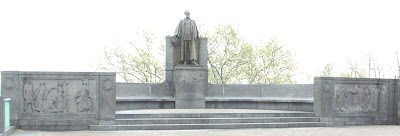
In “About the Sculpture” I discuss the reliefs flanking Schurz’s portrait statue, which recall more of Schurz’s achievements than could have been conveyed by his portrait alone. The reliefs are executed in the archaizing style made popular by Paul Manship (Prometheus, Essay 28).
“About the Subject” in Outdoor Monuments of Manhattan focuses on Schurz’s participation in the American Anti-Imperialist League, which maintained that the United States should not annex the Phillippines after the Spanish-American War. Schurz’s arguments are brilliantly expounded in a speech of 1899 that includes the famous line, “Our country – when right to be kept right; when wrong to be put right.”
Make a point of visiting this sculpture on a clear day – the view is spectacular. Below: reliefs at left, center and right.
Daniel Butterfield: OMOM Essay 52
The Butterfield project so exasperated Gutzon Borglum (best known for Mount Rushmore) that he eventually snapped that he wouldn’t care if the sculpture were heaved into the Hudson. Rather than analyzing this sculpture in detail, I wrote out a long series of questions re identifying the theme and evaluating the sculpture, to help readers practice thinking about sculpture on their own. This appears in Outdoor Monuments of Manhattanas “How to Read a Sculpture,” Appendix A, section 4.
“About the Subject” gives a brief biography of General Butterfield (d. 1901), including his actions on Wall Street’s first Black Friday. (See the Bennett Memorial, Essay 21.)
Hrmph: another photo taken when the sun was far too strong, but it’s the best close-up I have of Butterfield‘s face. Part of my mission for this blog is to upload images of important angles and details that didn’t fit into OMOM, so no, I won’t just use a better photo of a different detail.
Alexander Hamilton (Hamilton Grange): OMOM Essay 53

In “About the Sculpture” I discuss how this portrait at Hamilton Grange differs from the three other Hamilton sculptures in Manhattan. For images of all four, see Alexander Hamilton: A Brief Biography.
“About the Subject” in Outdoor Monuments of Manhattan recounts Hamilton’s organization of the country’s finances as first secretary of the Treasury, 1790-1795. I couldn’t resist also mentioning one of Hamilton’s most appealing characteristics: he was an immigrant who fell in love with New York, never wanted to live elsewhere, and became one of the city’s most energetic promoters. I never cease to be grateful that he and Jefferson agreed to send the feds south.
El Cid Campeador: OMOM Essay 54
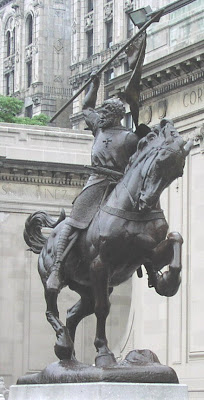
I first heard of the Cid while studying in Spain, where he’s a national hero on a par with George Washington in the United States. Thus it was a surprise to read the prestigious 1911 Britannica‘s disparaging estimate of him. I used this to raise the question of how one should properly evaluate a historical figure: by the standards of his own time, or of one’s own?
“About the Sculpture” identifies the theme based on the details of the sculpture. In Getting More Enjoyment from Art You Love, I discuss the Cid‘s theme at greater length and compare it to the equestrian George Washington at Union Square (Essay 13). The Getting More Enjoyment includes a photo of the Hispanic Society courtyard, where the Cid is the center of an ensemble.
In Appendix A, section 3 of Outdoor Monuments of Manhattan, I show how to evaluate the Cid in esthetic, philosophical, emotional and art historical terms.
Afterword and Appendixes of OMOM
In the Introduction to Outdoor Monuments of Manhattan, I described how I became interested in art history and (years later) in outdoor sculpture in Manhattan. The Afterword explains how I was introduced to Ayn Rand’s esthetics and why I became intent on developing a systematic method for studying art. It concludes with three answers to the crucial question: “Yes, but why would anyone else want to do that?”
While writing the manuscript I wrestled with the question of whether to include that question and its three answers in the Introduction, as motivation. I feared that in the Introduction, giving a lengthy explanation based on Ayn Rand’s esthetics and epistemology might lead potential readers to assume OMOM was yet another interminable, incomprehensible work of art criticism. By the time readers reach the Afterword, the answers to “Why analyze art?” merely summarize points I’ve already made. For motivation in the Introduction, I instead tried to describe my own introduction to art and to New York sculpture with such enthusiasm that it would draw readers in.
Appendix A, “How to Read a Sculpture,” has four sections:
- A list of questions to ask when looking at a sculpture, cross-referenced to the OMOM essays in which the topics are discussed
- A play-by-play description of the process by which I worked out the theme of Joan of Arc (Essay 44)
- Evaluation of the Cid (Essay 54) in esthetic, philosophical, emotional and art-historical terms
- Questions for readers to ask themselves about Butterfield (Essay 52), first to determine the theme and then to evaluate the sculpture
Appendix B is a list of OMOM sculptures by date of dedication. Appendix C is an alphabetical list of artists whose works are represented in OMOM. For each, it gives dates, place of birth, major works in the U.S., and all works by the artist that stand outdoors in the five boroughs of New York.
More
- In Getting More Enjoyment from Sculpture You Love, I demonstrate a method for looking at sculptures in detail, in depth, and on your own. Learn to enjoy your favorite sculptures more, and find new favorites. Available on Amazon in print and Kindle formats. More here.
- Want wonderful art delivered weekly to your inbox? Check out my free Sunday Recommendations list and rewards for recurring support: details here.